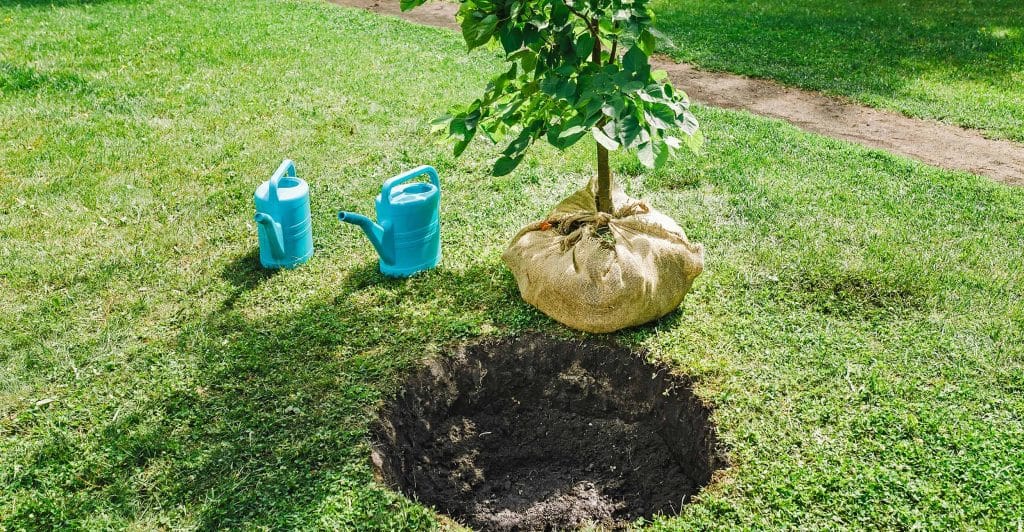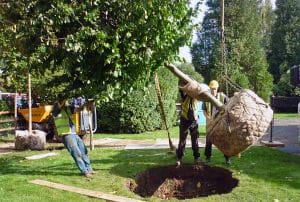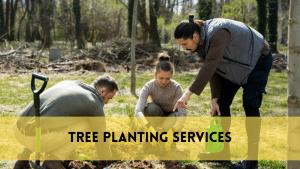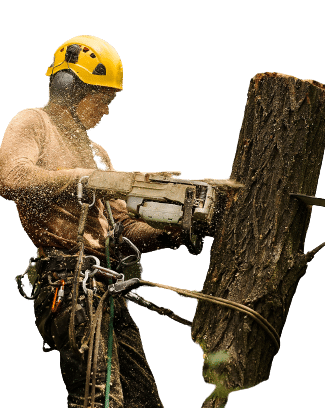Tree Replacement
Tree replacement is an essential part of preserving and improving landscapes. It entails strategically removing old trees and replacing them with new ones. This process is critical for a variety of reasons, including landscape aesthetics, ecosystem sustainability, and protecting the safety and health of the environment.
Trees play an important role in our environment, adding greatly to the esthetic attractiveness of communities, providing shade, enhancing air quality, and supporting various ecosystems. However, there are times when trees must be replaced owing to causes such as disease, age, or structural instability.
Why tree replacement is important
Environmental Health: Trees play an important part in environmental balance. They help to produce oxygen, absorb carbon dioxide, enhance air quality, and offer habitat for a variety of animal species. Replacing trees ensures that these environmental advantages continue.
Aesthetics of Landscapes: Trees increase the attractiveness of landscapes and communities. Trees that are well-maintained add to the visual appeal of communities, parks, and urban areas. Replacing trees that are sick, damaged, or unsuited for the site contributes to the area’s overall beauty.
Safety and structural integrity: Older or damaged trees might be dangerous. Weakening trees owing to disease, infestation, or structural concerns may offer risks such as falling branches or even full tree failure. The replacement of such trees assures the protection of both property and persons.
Ecosystem Support: Trees are essential components of ecosystems, providing shelter and food for a variety of animals and insects. Replacing trees helps to preserve biodiversity and a healthy ecology.
Community Benefits: Trees provide shade, minimize noise pollution, and raise property values. Communities benefit from healthy and well-maintained trees, making tree replacement an important part of community growth and well-being.
Signs that Indicate Tree Replacement
Deterioration and Rot: Visible indicators of deterioration, such as hollowed trunks, decaying branches, or fungal development on the tree, indicate weakened structural integrity and necessitate replacement.
Disease and Pest Infestation: Persistent indicators of disease, such as discolored or drooping leaves, bark irregularities, or bugs infesting the tree, indicate probable permanent harm, necessitating tree removal and replacement.
Weakness or Instability: Leaning trees, dangling limbs, or obvious fissures in the trunk indicate structural problems that might pose safety issues, necessitating repair.
Root Damage: Extensive root damage caused by construction activity or invasive growth can have a negative influence on a tree’s health, leading to its decline and eventual replacement.
Age and Decline: As trees age, they may show indications of decline such as scant foliage, limited growth, and decreasing vigor, signaling the need for replacement to maintain a healthy environment.
Tree replacement
Step-by-step guide on Tree replacement
1. Tree Assessment
Begin by examining the tree’s health, taking into account criteria such as illness, structural integrity, and general condition. If the tree displays evidence of permanent damage or constitutes a safety danger, it should be removed.
2. Obtain necessary licenses
Check local rules and obtain any necessary licenses for tree removal and tree planting. Compliance with local rules is critical for avoiding legal difficulties.
3. Tree Removal
Hire a professional arborist or utilize correct equipment to properly remove the current tree. Ensure that the removal procedure is carried out with accuracy, limiting harm to nearby regions.
4. Soil Preparation
Loosen the soil at the planting spot and add organic materials if necessary. Ensure enough drainage and soil quality to sustain the new structure.
5. Choosing a Replacement Tree
Based on local climate conditions, soil type, and available space, select an appropriate tree species. Choose healthy seedlings from well-known nurseries.
6. Establishing the New Tree
Make a hole somewhat larger than the new tree’s root ball. Place the tree with care, making sure the root collar is slightly above ground level. Fill the hole with dirt, carefully push it down, and thoroughly water it.
7. Mulching and Watering
Use mulch around the base of the newly planted tree to keep moisture in and weeds out. Water the tree frequently, especially during the first several years.
8. Post-Planting Care
Check on the tree on a regular basis and provide proper care and maintenance. If required, prune and protect against pests and harsh weather.
9. Long-Term Monitoring
Inspect the replacement tree’s development and health on a regular basis, giving continuous care as needed to guarantee its successful establishment and longevity.
Hiring Professional Services for Tree Replacement
Using experienced tree services for tree replacement assures a safe and effective operation, especially when working with large or complicated trees. Professional arborists have the experience, specific equipment, and understanding required for rapid and successful tree removal and replacement.
Arborists evaluate trees for health, structural integrity, and safety problems before recommending replacement. Throughout the process, they follow to industry best practices and safety requirements, reducing any property damage and protecting the safety of those around them.
Furthermore, professional services frequently involve the correct disposal of removed trees, decreasing environmental effect. Arborists advise on appropriate tree species, planting practices, and post-planting maintenance to enhance the new tree’s development and longevity.
Related Posts:
What Should You Look for In a Commercial landscapers
Environmental Impact of Tree Replacement
Tree replacement has a huge environmental impact, favorably altering numerous ecological elements. New tree plantings help to reduce carbon dioxide levels and air pollution while increasing oxygen generation. They operate as natural air filters, increasing air quality and limiting climate change consequences. Furthermore, trees play an important role in biodiversity conservation by providing habitat and food for a variety of creatures. Replacing trees not only helps to protect ecosystems, but it also contributes to the maintenance of a balanced and sustainable environment. Trees also help with soil stability, erosion prevention, soil fertility improvement, and water absorption. They help with stormwater management by lowering flooding danger and filtering contaminants from precipitation, so improving water quality. Recognizing the good environmental impact of tree replacement emphasizes its importance.
Cost Considerations in Tree Replacement
Tree replacement costs vary depending on a variety of factors. The key cost aspects are tree removal charges, which vary depending on the size, intricacy, and placement of the tree. Furthermore, the cost of obtaining a new tree is affected by the species, size, and origin of the tree. Professional planting services may increase the overall costs. Ongoing maintenance, such as watering, fertilizer, and trimming, contributes to the long-term expense of tree replacement. Furthermore, complying with municipal legislation and acquiring licenses for tree removal or planting incur additional costs. Other services including as stump removal and soil amendments are also included in the overall cost. Understanding these economic issues is essential for efficiently budgeting and planning a tree replacement project.Other services including as stump removal and soil amendments are also included in the overall cost. Understanding these economic issues is essential for efficiently budgeting and planning a tree replacement project. Balancing expenditures while prioritizing the health and vitality of freshly replacement trees promotes a successful and sustainable environment in the long run.
Maintenance Tips for Healthy Replacement Trees
Maintaining healthy replacement trees is critical for their effective establishment and long-term growth. Adequate watering is essential, especially during the first few years after planting, to maintain adequate root growth and hydration. Mulching around the base of the tree helps conserve moisture, controls soil temperature, and reduces weed development. Pruning dead or damaged branches promotes healthy development and structural integrity. Applying proper fertilizers enhances soil nutrients, however it is critical to follow prescribed parameters to avoid over-fertilization. Regular inspections for pests, illnesses, or structural concerns allow for early action to maintain tree health. Implementing preventative measures, such as guarding against harsh weather or lawn machine damage, protects the tree’s health. Property owners may encourage the development and vigor of replacement trees by meticulously following these management suggestions.
FAQS
1. What criteria indicate the necessity for tree replacement?
Decay, illness, instability, or root damage may signal the need for tree replacement.
2. How much does tree replacement normally cost?
Tree replacement costs vary depending on tree size, species, removal, and planting services, and can range from hundreds to thousands of dollars.
3. Can I transplant a new tree in the same area as the old one was removed?
Replanting in the same location is possible, but it is best to analyze soil conditions and potential problems first.
4. How long does it take for a newly replacement tree to grow roots?
The time it takes for roots to fully form varies by tree species, although it usually takes several years.
5. What environmental benefits can tree replacement provide?
Tree replacement enhances air quality, biodiversity, soil health, and stormwater management, all of which assist the environment.
Conclusion
Tree replacement is a complicated process that is essential for landscape health and environmental sustainability. It entails meticulous considerations such as spotting indicators for replacement, comprehending costs, and performing regular maintenance. Communities may preserve vibrant landscapes while promoting ecological balance and biodiversity by selectively replanting trees and encouraging their growth.






